Music, dance, history.
Glorious First of June in popular culture.
Dances entitled ‘Glorious First of June’
A Life of Exploration.
Matthew Flinders’ flute.
Preston’s Twenty four Country Dances for the Year 1795.1
Listen to mp3 Arranged by Roland Clarke 2014
Country dance: duple minor longways.
| A1 | 1-4 | 1st couple turn by the right hand. |
| 5-8 | Cast down one place. | |
| A2 | 1-4 | 1st couple turn left hand. |
| 5-8 | Cast up to the top. | |
| B1 | 1-8 | Lead down the middle and back, cast down one place. 2nd couple moving up. |
| B2 | 1-8 | Four changes of a circular hey. |
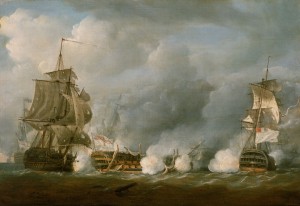
As the British Fleet entered battle, the band of HMS Brunswick which was stationed on the quarter-deck, struck up a lively tune, the new and popular,
Hearts of Oak.2 .
Matthew was a 20 year old midshipman on HMS Bellerophon at the Third Battle of Ushant, which took place on 1st of June, 1794. This battle between the British Royal Navy and the naval forces of Revolutionary France was fought in the Atlantic some 600 kilometres west of the Isle of Ushant, at the tip of Brittany.
Initially the Revolution in France had caused little alarm in England, even a small degree of sympathy; however, as the slaughter increased and whole families were sent to the guillotine, a great fear arose that this terror and extremism might cross the Channel.
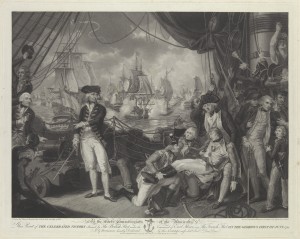
Print of the Celebrated Victory obtained by the British Fleet under the Command of Earl Howe. A young midshipman stands in the right foreground.4
The aged Admiral Lord Howe came out of retirement at the request of King George III to raise a fleet to protect Britain. With the best of the navy serving with Admiral Hood in the Mediterranean, there was considerable difficulty finding enough recruits to man the fleet. Among those conscripted was a substantial number of boys with no experience of the sea or fighting. On board Flinders’ ship, HMS Bellerophon, Rear-Admiral Thomas Pasley was “furious that some of his marines were too young and weak even to carry a musket”.3
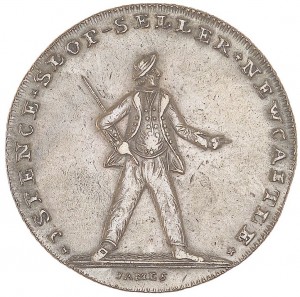
Newcastle halfpenny token commemorating the Battle of the Glorious First of June, 1794: sailor standing astride, his left arm extended.5
Despite this, the British fleet proved victorious, crushing the French fleet whilst incurring minimal damage itself. Matthew fought bravely on the day, was awarded prize money of £10, and a recommendation for promotion. He also created a series of magnificent tactical diagrams depicting the battle.
_____________________________
On the evening of the 10th of June 1794 a brilliant audience was as often happens assembled at the Opera House here in London … when an unknown individual entered with a wet newspaper in his pocket with tidings [of] Lord Howe and the English fleet …the wet newspaper had finally to be read from the stage and all the musical instruments human and other had to strike up ‘Rule Britannia’. The brilliant audience all standing and such of them as had talent joining in chorus …
a very glorious victory and the joy of people’s minds was considerable.5a
The Glorious First of June in popular culture
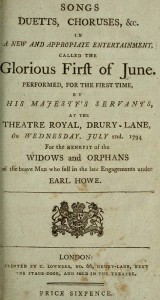
Title page of songs from the performance of The Glorious First of June by Richard Brinsley Sheridan and James Cobb. 1794.7
The great victory was celebrated in song, dance and theatrical performances within days of the news reaching London.6
13 June 1794 Covent Garden, a ‘Loyal Effusion’ consisting of a representation of the engagement and defeat of the French Navy.
19 June 1794 Ranelagh Gardens, a benefit night concert in aid of ‘the wounded Seamen…Widows & Children of the Brave Men who Fell in the late Glorious Naval Victory of the First of June’.
21 June 1794 King’s Theatre Opera House in the Haymarket, a concert performance of patriotic music was accompanied by transparencies of Admiral Howe and George III.
25 June 1794 Astley’s Amphitheatre, ‘A Naval Spectacle’ based on the conflict and advertised under a banner proclaiming ‘Victory, Victory’.
2 July 1794 Drury Lane, a large-scale Glorious First of June entertainment … a benefit for ‘The widows and orphans of the Brave Sailors who fell in the Glorious actions’ which took £841.19s. 0d at the box office.
Also in 1794 Sadler’s Wells, an entertainment ‘Naval Triumph; or the Wars of Old England … founded on the late victory of Earl Howe over the French Fleet on the Glorious First of June’ by Mark Lonsdale.
‘Howe triumphant! Or, the glorious first of June’. An heroic poem. By Romaine Joseph Thorn.
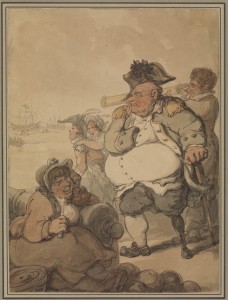
Admiral Pasley, the ‘Tough Old Commodore’ : ‘The bullets and gout have knocked his hulk about’. A caricature by Thomas Rowlandson ca.1800.9
2 June 1795 Robert Barker’s ‘Panorama of the Battle’ at Cranbourne Street, Leicester Square.
Many public benefit nights were held for the sailors maimed in action and for the families of those who lost their lives.
Matthew Flinders’ own commander, Admiral Sir Thomas Pasley, became a rear-admiral in April 1794, just before losing his leg on Bellerophon in Howe’s victory over the French at the Battle of the Glorious First of June. He received a pension of £1000 in compensation, a baronetcy and one of the gold medals and chains awarded to the seven flag-officers in that action, an unusually high number.8
Dances entitled ‘The Glorious First of June’10
Cahusac Listen to mp3
Twelve Country Dances…for the Year 1795.
1st and 2nd couples sett all 4 and change side=The same back again=Lead down the middle and up again=Hands 4 at top
Preston [Featured dance at the top of the page.] Twenty four Country Dances for the Year 1795.
Turn your partner with your right hand and cast one cu.=turn your partner with your left hand and cast up=Lead down 2 Cu: and up one=right and left at top.
Skillern Listen to mp3
Twelve Country Dances & Cotillons for the Year 1795.
The 1st Lady sett with the 2nd Gent: and turn with both hands. the Gent do the same. Down the middle. up again. Cast off, right and left at top.
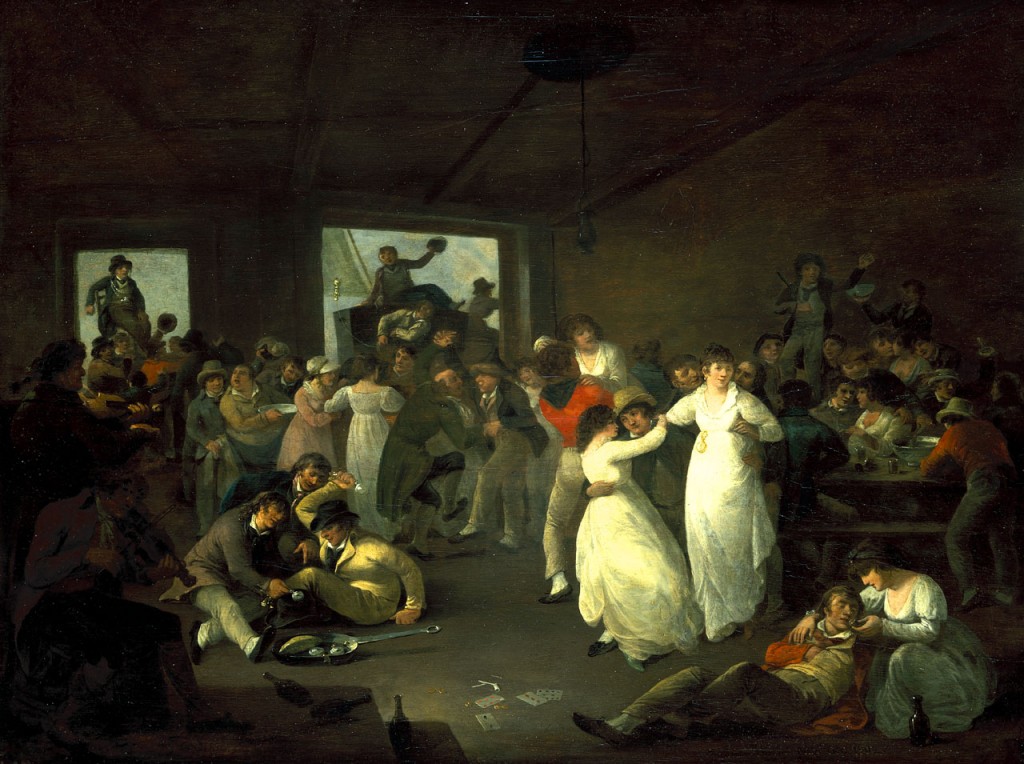
Scene in a Portsmouth tavern after one or more ships have been paid off.
Thought to be a painting of a celebration of the Battle of the Glorious First of June 1794.
The room is crowded with sailors and men and women carousing. Sailors, several with their arms around women, sit on low benches around a table to the right. This bears a china punch bowl and drinking mugs, with a sailor boy dancing on it. To the left, a group are dancing to the music of the two fiddlers on the far left. Some of the dancers are in couples and others are groups of men carousing (including a sailor dancing with a Jewish pedlar, a class well-known as purveyors of frippery to seamen).
Courtesy of the British Maritime Museum.11
Life of Exploration
Matthew Flinders was born on 16 March 1774 at Donington, Lincolnshire, England. As a small boy he read Robinson Crusoe and set his heart on adventure, determined to embark upon a life of exploration.
The romantic appeal of travel took hold in the eighteenth century with an increasing interest in foreign lands and exotic experiences. The story of Robinson Crusoe 12 was inspired by accounts of the stranding of a lone man, Alexander Selkirk, on an isolated island in the Pacific during William Dampier’s voyages in the South Seas.
The sea held an immense allure and many boys were drawn to the navy as a way to see the world.13 At 15, Matthew ignored his father’s wish that he follow him into medicine and instead joined the Royal Navy. He first sailed on HMS Alert and the following year accompanied Captain Bligh as a midshipman on HMS Providence. This was Captain Bligh’s second trip to Tahiti14 to collect breadfruit plants for the West Indies, the previous expedition ending in the famous mutiny on the Bounty. Tahiti was the most exotic location imaginable for a young Englishman, a paradise where love was free.16 Flinders took advantage of the favours of the island beauties, but unfortunately contracted venereal disease in the adventure, which may have contributed to his untimely death.
Upon returning to England in January 1794, Flinders was engaged as a midshipman on HMS Bellerophon and subsequently fought in the battle of the Glorious 1st of June.
Over the next eight years [1795-1803], Flinders made two trips to New Holland, where he carried out his prodigious work exploring and mapping the coastline:
Matthew Flinders was among the world’s most accomplished navigators and hydrographers, though his exploration was mostly made in unsuitable, leaky or rotten ships….[He] is remembered not only for his achievements in the realm of discovery but also for great improvements in the science of navigation…17
As the captain of HMS Investigator, Flinders wrote, ‘I had begun very early to put in execution the beneficial plan, first practised and made known by the great Captain Cook.’ This plan included keeping the ship scrupulously clean, ensuring the crew did not sleep in wet clothes, supplying fresh food whenever possible and, significantly, ‘when the evenings were fine, the drum and fife announced the fore castle to be the scene of dancing; nor did I discourage other playful amusements which might occasionally be more to the taste of the sailors, and were not unseasonable.’18
Flinders was accompanied on his explorations by his celebrated cat, Trim, named after a character in Laurence Sterne’s novel, Tristram Shandy20 who attended to his master ‘with great fidelity and affection’.
Trim is renowned for having sailed around the world and circumnavigated Australia. After the black and white cat disappeared in Mauritius, possibly cooked in a stew by hungry slaves, Matthew wrote a biography and epitaph for his beloved pet.
A key aspect of Flinders’ life was his interaction with the native people with whom he expressed a ‘deep sympathy and understanding’. Continuing the practices of Cook and members of the First Fleet, he used music and dance in an attempt to befriend the aborigines:
They welcomed him on shore with a dance, joining hand in hand, round a tree, probably to express their unanimity;
To restore their confidence… three of the sailors, who were Scotch, attempted to dance a reel, but made a very bad business of it, which the natives seemed to view either without amusement or curiosity,… they parted with them in a very friendly manner.
Other natives soon made their appearance, but it was some little time before they overcame their dread of approaching those strangers with fire-arms; but, encouraged by the three who were with them, they came up, and a general song and dance commenced.22
Matthew Flinders and the flute
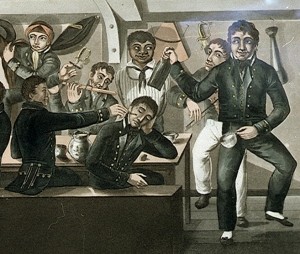
Interior of Midshpman’s berth. During the mid-eighteenth century, flute playing became a fashionable accomplishment for young men.23
Flinders may have supplied the music for these dances himself, as he was an accomplished flautist and music was an important element of his life.
In 1803, as Matthew was returning to England, the unseaworthy state of his vessel forced him to land at the French colony of Mauritius. Here the over-zealous governor, De Caen, imprisoned Matthew, taking him for a spy.
After a short time De Caen relaxed the strictness of Flinders’ detention and allowed him to live with friends outside the town, but refused to release him, despite instructions from the French Government and Napoleon himself. He was generally well treated and made many close friendships.
Matthew was apparently very fond of his flute, which became a vital source of recreation during his imprisonment. He writes of practising every morning until his fingers became too tired. He practised music of Pleyel and Rosetti, played waltzes for ladies to dance, accompanyed Madame Chaval’s excellent harpsichord, played trios with the harpsichord, bass, and flute, He also expressed his intention of purchasing more music upon his return to England ‘that is set for the flute … all Pleyels musick, Mozarts, Haydens, Hoffmiesters and Deviennes’, but did complain of the price of music there. 26
One of the activities he describes was dancing:
In the evening, there was dancing, but as I neither waltze or dance the French contre-dance, had no person with whom I could hold a conversation the least interesting, my evening passed dull enough.
We returned home at midnight by moonlight. Dancing went on till two in the morning when we supped, and the dancing afterwards continued to daylight.
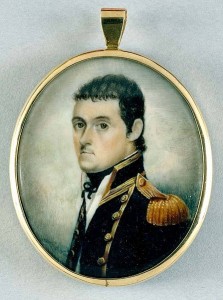
Matthew Flinders, ca. 1800 – watercolour miniature portrait.
Courtesy of the State Library of New South Wales.27
After six and a half years the governor released Flinders.
En route to England he stopped at the Cape of Good Hope. There he attended a society ball where the ‘Dutch ladies … are fresher coloured, but have less grace than the young ladies at the Isle of France’, another ball given by the governor in honour of the Prince of Wales’ birthday, and a play house, where a Dutch version of the ballet, The Shipwreck26 was performed.
He finally reached England in October 1810 and was reunited with his wife, Ann. He recorded taking his flute to be serviced, ‘left my old Flute at Potters to be put to rights’ and several days later ‘Went out afterwards and bought music’.
In declining health, he spent his last years writing the official account of his work A Voyage to Terra Australis. This was published on 18 July 1814, the day before he died, aged 40.
This page was of particular interest as my own family is related to Matthew Flinders.
Heather Clarke, 1st June, 2014.
______________________________________________________________
Footnotes
1Original manuals for the dances of Cahusac, Preston, and Skillern are held in the British Library.
2The ‘Defence’ at the Battle of the First of June, 1794. BHC0474 Pocock, Nicholas, 1811.
National Maritime Museum, Greenwich, London, Greenwich Hospital Collection.
http://collections.rmg.co.uk/collections/objects/11966.html
also
Museums of The Mercian Regiment (Worcestershire) and (WFR Collection)
http://www.wfrmuseum.org.uk/1st_june.htm
3 In the Hour of Victory. The Royal Navy at War in the Age of Nelson.
Sam Willis, Atlantic Books, London, 2013. P 36
4 To the Lords Commissioners… This Print of the Celebrated Victory obtained by the British Fleet under the Command of Earl Howe over the French Fleet on the Glorious First of June 1794. PAH7879 1 Oct 1795, Brown, Mather.
National Maritime Museum, Greenwich, London.
http://collections.rmg.co.uk/collections/objects/147826.html
5Newcastle halfpenny token commemorating the Battle of the Glorious First of June, 1794. Obverse: A sailor standing astride, his left arm extended. Legend: ‘SPENCE. SLOP. SELLER. NEWCASTLE.’ Reverse: A foul anchor. Legend: ‘IN COMMEMORATION OF THE GLORIOUS FIRST OF JUNE’. Below: ‘1794’. MEC1936. C. James.
National Maritime Museum, Greenwich, London.
http://collections.rmg.co.uk/collections.html#!csearch;searchTerm=MEC1936
5aFraser’s Magazine, Volume 20. By James Anthony Froude, John Tulloch. G. W. Nickisson, 1839.
http://books.google.com.au/books?id=qsszAQAAMAAJ&lpg=PA76&ots=06_-BIqDzQ&dq=the%20glorious%201st%20of%20june%201794%20tune&pg=PA76#v=onepage&q=the%20glorious%201st%20of%20june%201794%20tune&f=false
6Celebrity, Performance, Reception: British Georgian Theatre as Social Assemblage By David Worral, 2013
books.google.com.au/books?isbn=1107043603
7‘Songs duetts, choruses, &c. in a new and appropriate entertainment, called The glorious first of June. Performed, for the first time, by Their Majesties servants at the Theatre Royal Drury Lane, for the benefit of the widows and orphans of the brave men who fell in the engagements under Earl Howe.’ Sheridan, Richard Brinsley.
The Hopkinson Verdi Collection, National Library of Scotland
http://digital.nls.uk/94640136
8Admiral Sir Thomas Pasley Bt (1734-1808) by Thomas Rowlandson. PAF5936
National Maritime Museum, Greenwich, London.
http://collections.rmg.co.uk/collections/objects/100763.html
9ibid
10Robert M. Keller, compiler. Dance Figures Index: English Country Dances, 1650-1833 on line at www.danceandmusicindexes.org
11Sailors Carousing. BHC1090. 1802. Ibbetson, Julius Caesar.
National Maritime Museum, Greenwich, London, Caird Collection.
http://collections.rmg.co.uk/collections/objects/12582.html
12This in turn inspired the dance, Robinson Crusoe, published in various formats between 1775 and 1809.
13The Wooden World. An Anatomy of the Georgian Navy. N.A.M. Rodger
Collins, London. 1986
14Inspired the dance: Trip to Ottahite 1787
15painting of Matthew Flinders ca.1788-ca.1790 by Gainsborough Dupont.
State Library of Victoria
http://digital.slv.vic.gov.au/view/action/nmets.do?DOCCHOICE=3058671.xml&dvs=1401066173664~786&locale=en_GB&search_terms=&adjacency=&divType=&usePid1=true&usePid2=true
16Inspired the dance:Island of Love 1775
17Australian Dictionary of Biography,
http://adb.anu.edu.au/biography/flinders-matthew-2050
18“A Voyage to Terra Australis Volume I”. FRIDAY 16 OCTOBER 1801
http://gutenberg.net.au/ebooks/e00049.html
19Inspired the dance: Tristam Shandy, published five times between 1762 and 1783.
20Matthew Flinders’ biographical tribute to his cat Trim 1809 (FLI11) Isle of France, December 1809
http://flinders.rmg.co.uk/DisplayDocument2410.html?ID=92
TO THE MEMORY OF
TRIM
The best and most illustrious of his race
The most affectionate of friends, faithful of servants, and best of creatures
He made the tour of the globe,
and a voyage to Australia, which he circumnavigated,
and was ever the delight and pleasure of his fellow voyagers.
Written by Matthew Flinders in memory of his cat.
21“Trim, the cat, in Donington, Lincs. at the feet of his master, Matthew Flinders. 218733” Photo by Rodney Burton,
www.geograph.org.uk
22“A Voyage to Terra Australis Volume 2”.
http://gutenberg.net.au/ebooks/e00050.html
23Interior of a Midshipman’s Birth (caricature). PAF3730
This scene of life aboard ship in the Navy demonstrates that even in cramped conditions leisure time was well used. Music is played on pipe and fiddle while the midshipmen drink from their earthenware jugs and cups. Others read or play cards to while away the time. Midshipmen were relatively privileged in this case, having a black mess servant to attend to them. 12 Aug 1821, Humphrey, George.
National Maritime Museum, Greenwich, London
http://collections.rmg.co.uk/collections/objects/127865.html
24 Flute. Repro ID D5231 Wood and ivory flute which belonged to Matthew Flinders.
National Maritime Museum, Greenwich, London.
http://flinders.rmg.co.uk/displayResourcef226.html?ID=1010&ResourceTyp…etc
25Matthew Flinders Private Journal, 17 December 1803 to 8 July 1814
Mitchell Library, State Library of New South Wales
http://acms.sl.nsw.gov.au/_transcript/2013/D17745/a007.html
26 Shipwreck, a pantomimic ballet by John Byrne (1756-1845.) Also the country dance: Thompson 1788.
27Matthew Flinders, ca. 1800 – watercolour miniature portrait. 1 watercolour on ivory miniature : on obverse, backed with another thin piece of ivory and held together by a metal ‘ribbon’, is a lock of hair. Case and framing are twentieth century.
Mitchell Library, State Library of New South Wales.
http://acmssearch.sl.nsw.gov.au/search/itemDetailPaged.cgi?itemID=402338
________________________________________________________________________
The information on this website www.historicaldance.au may be copied for personal use only, and must be acknowledged as from this website. It may not be reproduced for publication without prior permission from Heather Clarke.
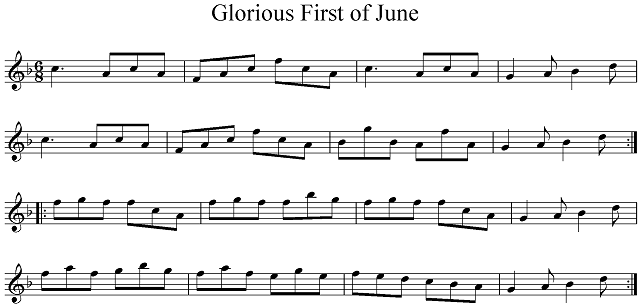
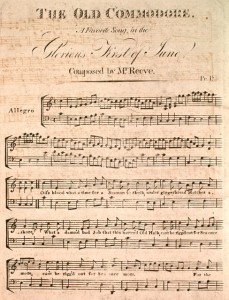
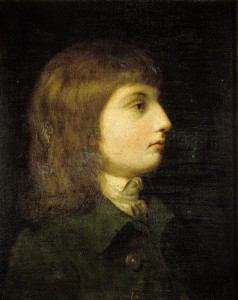
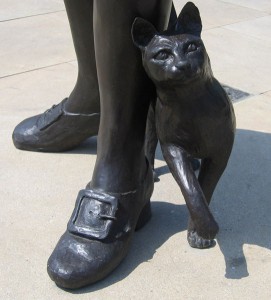
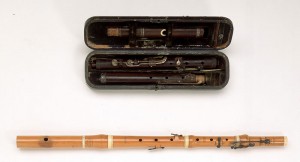


One Response to Matthew Flinders and the Glorious First of June